1832: Siege of Otaka
June 8, 2019
By AHNZ
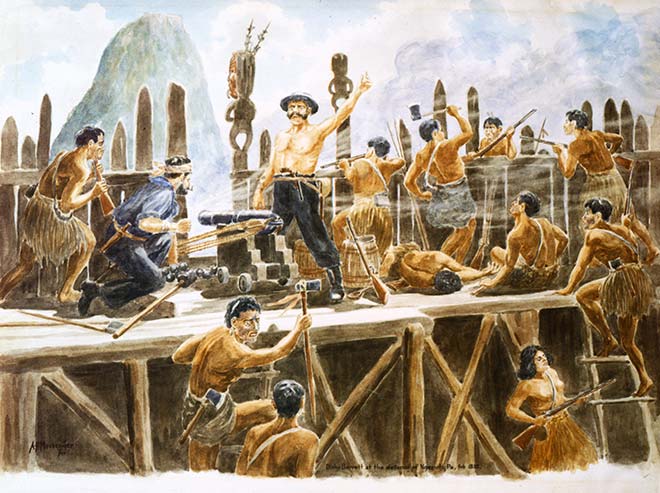 Taranaki Maori faced the greatest apocalyptic disaster in their history over the fighting season of 1831/2. Their old enemy from the north, the Waikato Maoris, were on the war path again. This time it would be for keeps. With no Ngati Toa allies in the south to protect them (Te Rauparaha had moved on) they were surely doomed.
Taranaki Maori faced the greatest apocalyptic disaster in their history over the fighting season of 1831/2. Their old enemy from the north, the Waikato Maoris, were on the war path again. This time it would be for keeps. With no Ngati Toa allies in the south to protect them (Te Rauparaha had moved on) they were surely doomed.
Pukerangiora
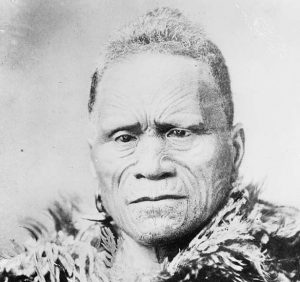 Future Maori King, Potatau Te Wherowhero, genocidally swept down from the north. The great fighting pa of Pukerangiora lasted only 13 days because it was packed with hundreds of refugee women and children and little provisions.
Future Maori King, Potatau Te Wherowhero, genocidally swept down from the north. The great fighting pa of Pukerangiora lasted only 13 days because it was packed with hundreds of refugee women and children and little provisions.
“Many women threw themselves with their children over the cliff into the Waitara [river.] Next day the captives were brought before Te Whereo Whero..himself slew many scores with a favourite greenstone weapon. A miserable train of slaves were spared to labour in the villages of the Waikato.”- p117, Reeves (1898)
Future royalty, Te Wherowhero, killed hundreds¹ of prisoners until his arm became so tired bludgeoning with his bloody greenstone club he had to stop. But still he wanted more Taranaki slaughter.
Otaka
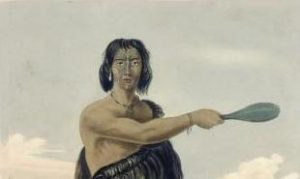
Chief Te Wharepouri arguably saved the Taranaki Maori from oblivion. As other wise chiefs had done, Wharepouri persuaded European seamen to join his tribe by marrying in. Richard ‘Dicky’ Barrett and other young men were given a fortune in land, resources to trade, Maoris to command, and wives who gave them children. By enticing Barrett et al to settle at Ngamotu, Wharepouri’s people gained superior Western farming, warcraft, housing, shipping, and weapons technology. The economic and trade ties this alliance afforded Taranaki Maori was worth almost anything. Making a brother of Barrett was the smartest thing any Taranaki Maori ever did.
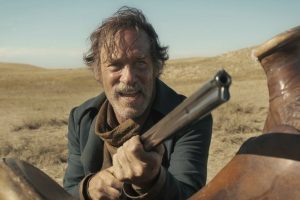 In February 1832 when Te Wherowhero and his Waikato invaded they did not kill Te Wharepouri. Some 300 Ngamotu people, along with their eight Pakeha-Maori family (Bosworth, Oliver, William Keenan, and another. Love and Barrett)² took up position in the pa of Otaka. They were helpless as Pukerangiora fell but rather than run they determined to fight and survive.
In February 1832 when Te Wherowhero and his Waikato invaded they did not kill Te Wharepouri. Some 300 Ngamotu people, along with their eight Pakeha-Maori family (Bosworth, Oliver, William Keenan, and another. Love and Barrett)² took up position in the pa of Otaka. They were helpless as Pukerangiora fell but rather than run they determined to fight and survive.
Barrett and his tribe repelled the Waikato invaders, firing shot then scrap iron then pebbles out of their 4 ships guns. Te Whero Whero swore he would enslave them but was outmastered by Barrett’s tactics and the bravery of his men; They retreated back to their country never to return.³
Exodus
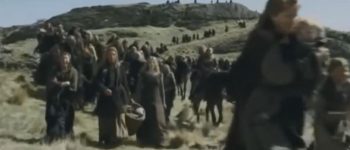
Te Wharepouri, Barrett, and the gathered up Taranaki survivors abandoned their lands for fear of future invasion. They found a new home in what will become the Wellington area nearer the protection of Te Rauparaha. They also have the advantage of arriving before the New Zealand Company does so that they are in a position to sell them the land! Later, Barrett will return to his old home and die there in a whaling accident aged only 40. For the most part the Taranaki country is an abandoned wasteland now, remaining so until new Settlers come to make it safe and add value. At that point, some 20 years after exiting, the departed tribe will nip back to Taranaki to demand payment for “their” land. Meanwhile the not-so-innocent Taranaki Maori pop down to inflict genocide upon the Chatham Islands Moriori (ref. 1835: The Moriori Genocide and 1835: Among The Trees.)
—
1 ref. p437 NZH&H (1973)
2 History and Traditions of the Maoris of the West Coast North Island of New Zealand Prior to 1840; Smith (1910); NZETC
3 Interesting side note: The Waikato messengers were permitted to enter Otaka and see what they were up against. Also, the besiegers formally announced their final attack the day before. Reeves calls this “childish chivalry” but it is totally consistent with the mindset of Honour Moral Culture as Cook had also observed.
The Long White Cloud; Reeves (1898)
image ref. Tawhiao Te Wherowhero, son and successor to Potatau Te Wherowhero’s throne; NZHistory.govt
image ref. Dicky Barrett at Otaka Pa, 1832; A. H. Messenger, Taranaki Museum & Library; Te Ara
image ref. Chief Te Wharepouri; Alexander Turnbull Library
image ref. Natives not match for Western warcraft; The Ballad of Buster Scruggs (2018)
image ref. Exodus to Helm’s Deep; The Lord of the Rings: The Two Towers (2002)
19 thoughts on "1832: Siege of Otaka"
Leave a Reply
 Like Comment Share
Like Comment Share

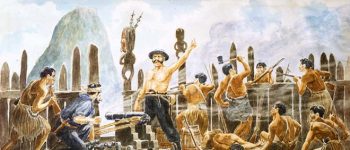




This ties in with the Waikato slaughter of Ngati Toa and Ngati Raukawa in 1822/23, at which time both tribes fled to Paremata/Mana and Otaki respectively, to live in relative peace, even building a church in the 1870’s.
After 1840 both tribes petitioned the British, under the treaty, to reclaim their lands. It wasn’t until the 1860’s that British troops could reach the area, and it was secured in the late 1870’s, only for the tribes to hand the land on to the British, preferring their new home north of Wellington.
I didn’t know about that, sounds very interesting. Hopefully it’ll be in Stafford’s biography which I’m reading now and am nearly into the 1870s. Not sure why Ngati Toa would think they had rights since they were just passing through. But perhaps I’ll learn more soon, thanks.
The church you mean, I guess, is Rangiatea Church est.1851.
Ref. http://nzb3.anarkiwi.co.nz/2020/02/25/slave-culture-going-hungry/
WOW!!
This is so interesting. We need more history of this kind, so that we can debunk some erogenous and outrages claims that are being made.
You’re a star and I thank you for your efforts.
Well, that’s what I’m here for. Please read and share. Appreciate your feedback
I have been researching my Ancestor from a DNA test which led me to https://www.wcl.govt.nz/maori/wellington/tupunabeckham.html
My grandfather had told me about George Ashdown with roughly a dozen whaler’s and the battle of Otaka. How he had migrated south afterward with some other whaler’s and their Maori wives. Which was why we had Maori land near Wellington. I noticed that Ashdown wasn’t on your list of participates if you wanted to add a couple names!
Thanks for the article.
Grandad also always said “If you want a pretty Maori girl go to the Waikato. They stole them all.” haha.
Thank you for adding that in. Wouldn’t it be great to have a diary of one of these fighters?
“Mata Pekamu was married to the whaler George Ashdown who was one of thirteen pakeha whalers and traders of Nga Motu who took part in the Battle of Otaka, 1830. These men included Billy Bundy, John Agar Love, Dicky Barrett, William Keenan, Joseph Phillips and others..”
Hi Kurt lm a decent of Mata and George Ashdown , family has alot of histroy
Daniel Sheridan left a detailed account of the siege. See Robert McNab, “The Old Whaling Days’ 1913: pages 38-60,
Barrett also describes the siege in his journal. Alexander Turnbull Library, MS papers1736.
Thanks for that. McNab’s a bit far north of is usual area of interest..
“The letters tell the story of the three week siege with a vividness and reality that could only be infused by one taking an actual part in its varying fortunes.”
Ref. https://nzetc.victoria.ac.nz/tm/scholarly/tei-McNOldW-t1-body-d1-d3.html#n56
We have a headstone in our urupa in Waikanae of a child of George Ashdown. Hard to read the lettering
Ra
Thank you. Real primal early history
I have been researching the family plot for the AMES family in Bolton Street Cemetery, where I take tours on behalf of the Friends of the cemetery. This has led me to learn more about George ASHDOWN, and his Maori wife, Mata Pekamu TAMATUHIATA, by whom he seems to have had 7 or 8 children, the 5th of whom was also called George, born in 1850. George (father) died in 1858 in Johnsonville, 2 years after marrying Mary Ann Ames, widow of James Ames, who was for a time resident on Tokomapuna Island. George’sand his name and date of death is inscribed on the Bolton Street Cemetery headstone. I am therefore interested whether you have any more information about George Ashdown, died 1865, who is buried in Ruakohatu Urupa. I note the design of the headstone at Bolton St is the same as that of the one in Ruakohatu Urupa.
Barbara Mulligan
021673640
I don’t but hopefully this page will help those interested to find each other. I did visit last week the grave of John Guard who was married to George’s sister Maraea who was not herself buried there (Port Underwood.)
Ref. https://billiongraves.com/grave/George-Ashdown/18806228
Daniel Sheridan and Richard ‘Dicky’ Barrett, both left accounts of the siege. Sheridan’s is the most detailed and a pretty graphic one at that.
For these and additional references to the battle check out chapter 9, The Siege of Otaka Pa, in my book ‘Tribal Guns and Tribal Gunners’ (2013).
Available in most NZ libraries it devotes 15 pages to the siege.
Good effort Trevor. I’ll pick that up next time I’m at Waimak library and read it with great interest. Also keen to review a big fat book Mrs Guard showed me at Kakapo Bay that had every old gun in New Zealand in it including the one in her back paddock. You probably have it yourself but I lost the title.
Ah! I thought I had accessed all the old books that mention one or more of19th century NZ’s old Maori and Pakeha smoothbore artillery pieces.
Thanks for the heads up on this source. Will contact National Library’s ‘Ask a Librarian’ for help locating this publication.
Interestingly, late last week I was contacted about a 12 pound gun stone found near an old Ngati Toa urupa on the Waikanae coast.
An intriguing link to the early Maori artillerymen who found purchasing iron round shot from the shipping inordinately expensive.
It was probably ‘Great Guns: The Artillery Heritage of New Zealand’
Thanks for the suggestion. I already have Cooke and Maxwell’s ‘Great Guns: The Artillery Heritage of New Zealand (2013).
It was published in the same year as my own ‘Tribal Guns and Tribal Gunners: The Story of Maori Artillery in 19th Century New Zealand’.
Hopefully, the research librarians at the National Library will be able to help further.